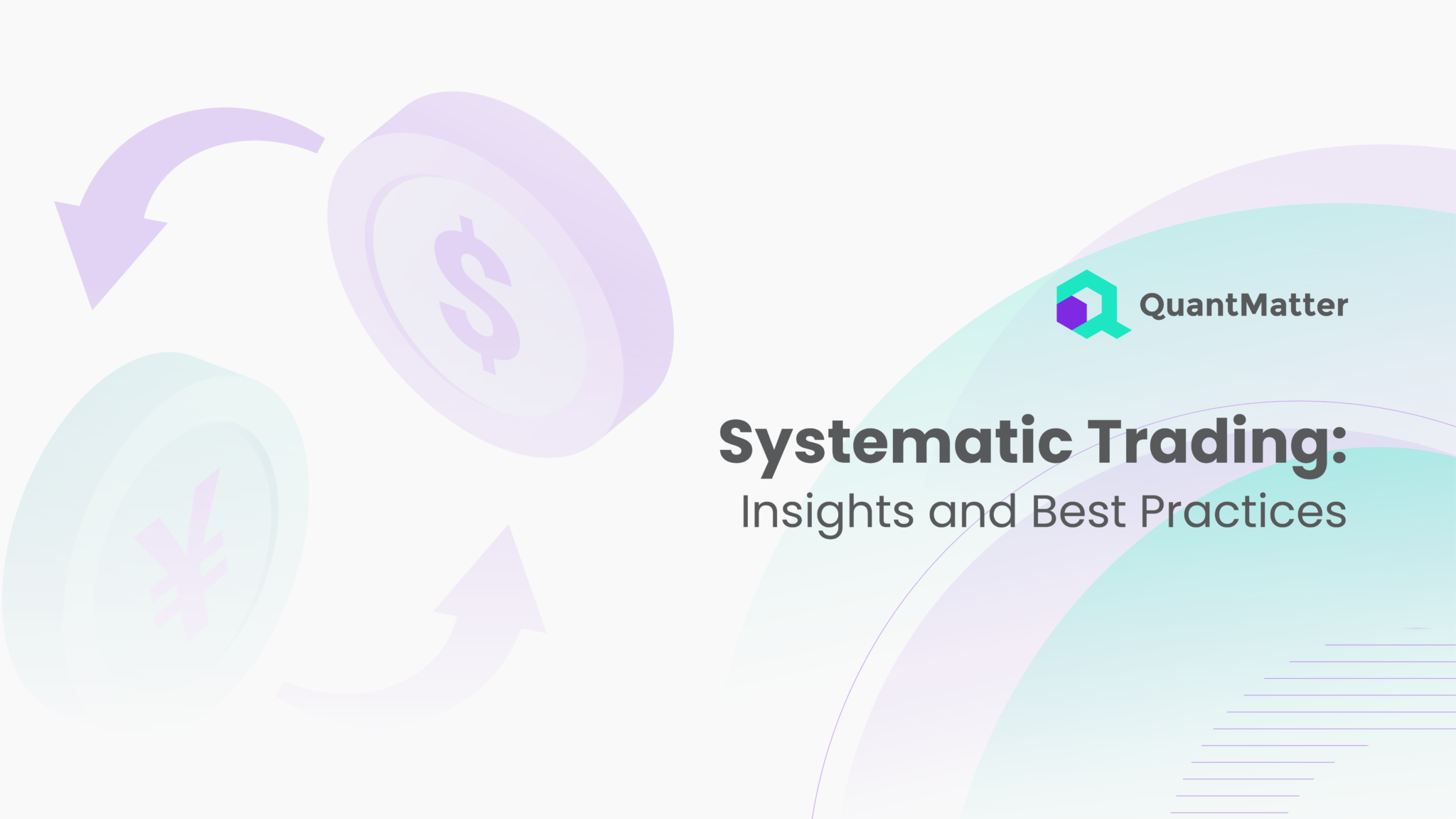
In the world of trading, the ability to make informed and consistent decisions is crucial. Systematic trading, a methodical approach to trading, has gained popularity among traders for its ability to minimize emotional bias and enhance decision-making processes. By relying on predetermined rules and algorithms, systematic trading provides a structured framework that can be particularly beneficial in volatile markets.
Understanding systematic trading involves delving into the principles that govern it and the technologies that support it. Traders who adopt systematic strategies can benefit from a disciplined approach, where every decision is guided by data and predefined criteria. This approach not only helps in managing risk but also in capitalizing on market opportunities with precision.
In this article, we will explore the various facets of systematic trading, from its core principles to the best practices that can help traders succeed. Whether you are a novice trader looking to understand the basics or an experienced trader aiming to refine your strategies, this comprehensive guide will provide valuable insights and practical advice.
What is Systematic Trading?

Systematic trading is a disciplined approach to trading that relies on predefined rules and algorithms to make trading decisions. Unlike discretionary trading, where decisions are based on the trader’s intuition and judgment, systematic trading follows a structured framework designed to eliminate emotional bias and improve consistency.
At its core, systematic trading involves the use of computer algorithms to analyze market data and execute trades. These algorithms are programmed to follow specific rules that can be based on a variety of factors, such as technical indicators, statistical models, or economic data. By automating the decision-making process, systematic trading ensures that every trade is executed according to the established criteria, regardless of market conditions or emotional influences.
One of the key advantages of systematic trading is its ability to process large volumes of data quickly and accurately. This enables traders to identify patterns and trends that might be missed by the human eye. Additionally, systematic trading allows for backtesting strategies against historical data, providing insights into their potential effectiveness before they are applied in live markets.
Benefits of Systematic Trading

Systematic trading offers several advantages that make it an attractive option for traders seeking a reliable and efficient approach to the markets. Here are some of the key benefits:
1. Consistency and Discipline
One of the most significant benefits of systematic trading is the consistency it brings to the trading process. By following predefined rules and algorithms, traders can eliminate the emotional biases and impulsive decisions that often lead to losses. This disciplined approach ensures that all trades are executed according to the same criteria, leading to more predictable and stable outcomes.
2. Data-Driven Decision Making
Systematic trading relies on data analysis and statistical models to inform trading decisions. This data-driven approach allows traders to make informed decisions based on objective criteria rather than subjective judgment. As a result, traders can better understand market trends, identify opportunities, and manage risks.
Also Read: 21 Best Crypto Market Makers in 2024
3. Backtesting and Optimization
Another advantage of systematic trading is the ability to backtest strategies against historical data. This process involves running the trading algorithms on past market data to evaluate their performance and effectiveness. Backtesting helps traders identify potential weaknesses in their strategies and optimize them for better results before applying them in live markets.
4. Risk Management
Effective risk management is crucial in trading, and systematic trading provides robust tools for this purpose. By setting predefined rules for entry, exit, and position sizing, traders can manage their risk exposure more effectively. This approach helps in limiting losses and protecting capital, ensuring that traders can survive in the market over the long term.
5. Efficiency and Speed
Systematic trading leverages computer algorithms to analyze data and execute trades rapidly. This efficiency allows traders to capitalize on market opportunities as soon as they arise, without the delays associated with manual decision-making. The speed and accuracy of systematic trading can be particularly advantageous in fast-moving markets.
Key Strategies in Systematic Trading

Systematic trading encompasses a variety of strategies, each designed to capitalize on different market conditions and opportunities. Here are some of the key strategies that traders often use:
1. Trend Following
Trend following is one of the most popular systematic trading strategies. It involves identifying and trading in the direction of a market trend, whether it is upward or downward. This strategy is based on the premise that markets often move in sustained trends, and by aligning trades with these trends, traders can maximize their profits. Trend-following systems use technical indicators such as moving averages, trendlines, and momentum oscillators to identify trend direction and potential entry and exit points.
2. Mean Reversion
Mean reversion strategies are based on the idea that asset prices tend to revert to their historical averages over time. When prices deviate significantly from their mean, these strategies anticipate a reversal and trade accordingly. Mean reversion can be applied to various timeframes and asset classes, and it often involves technical indicators such as Bollinger Bands, relative strength index (RSI), and moving average convergence divergence (MACD) to identify overbought or oversold conditions.
3. Arbitrage
Arbitrage strategies seek to exploit price discrepancies between related markets or instruments. These strategies aim to profit from temporary inefficiencies by simultaneously buying and selling similar assets. For example, a trader might engage in statistical arbitrage, where they identify and trade pairs of correlated stocks that have temporarily diverged in price. Arbitrage strategies require fast execution and precise risk management to be effective.
4. Momentum
Momentum trading strategies capitalize on the continuation of existing market trends. Unlike trend following, which may capture longer-term trends, momentum trading focuses on short- to medium-term price movements. Traders using this strategy look for assets that have shown strong recent performance and aim to ride the momentum until it shows signs of weakening. Key indicators for momentum trading include moving average crossovers, relative strength, and volume analysis.
5. Market Making
Market making involves providing liquidity to the market by simultaneously offering to buy and sell an asset at different prices. Market makers profit from the bid-ask spread, the difference between the buying and selling prices. This strategy requires a deep understanding of market dynamics and the ability to manage inventory risk. Market makers use sophisticated algorithms to adjust their quotes in response to market conditions and maintain balanced portfolios.
6. Algorithmic Execution
Algorithmic execution strategies focus on optimizing the process of executing trades. These strategies are designed to minimize market impact, reduce transaction costs, and improve the execution quality. Common algorithmic execution strategies include VWAP (Volume Weighted Average Price), TWAP (Time Weighted Average Price), and implementation shortfall, each aiming to achieve different execution objectives based on volume and time considerations.
Best Practices for Systematic Trading
To succeed in systematic trading, it’s essential to follow best practices that enhance the effectiveness of your strategies and manage risks effectively. Here are some key best practices for systematic trading:
1. Develop and Test Your Strategy Thoroughly
Before implementing any trading strategy, it’s crucial to develop it carefully and test it thoroughly. This involves backtesting the strategy on historical data to evaluate its performance under various market conditions. Ensure that the strategy performs well not only during favorable market conditions but also during periods of volatility and downturns. Robust testing helps identify potential weaknesses and areas for improvement.
2. Use Reliable Data Sources
Accurate and timely data is the backbone of any systematic trading strategy. Ensure that you are using reliable data sources for your market analysis and decision-making processes. Inaccurate or delayed data can lead to suboptimal trading decisions and increased risks. Additionally, consider using multiple data sources to cross-verify information and improve the accuracy of your trading signals.
3. Implement Strong Risk Management
Risk management is a critical component of systematic trading. Define clear rules for position sizing, stop-loss levels, and risk exposure limits. Use risk management techniques such as diversification, hedging, and setting maximum drawdown limits to protect your capital. By managing risk effectively, you can reduce the impact of losses and increase the longevity of your trading activities.
4. Keep Your Strategies Simple
While it might be tempting to develop complex trading strategies, simplicity often leads to better results. Simple strategies are easier to understand, implement, and monitor. They are also less prone to overfitting, a common issue where a strategy performs well on historical data but fails in live markets. Focus on developing strategies that are based on clear, logical rules and can be easily adjusted as market conditions change.
5. Monitor and Adapt to Market Conditions
Markets are dynamic and constantly evolving, so it’s important to monitor your strategies regularly and adapt them to changing conditions. Continuously review your performance metrics and be prepared to make adjustments to your strategy as needed. This might involve updating your algorithms, changing your risk parameters, or incorporating new data sources. Staying flexible and responsive to market changes can help maintain the effectiveness of your trading strategies.
6. Maintain Robust Technology Infrastructure
A reliable and efficient technology infrastructure is essential for systematic trading. Ensure that your trading platform, data feeds, and execution systems are robust and capable of handling high-frequency trading activities. Regularly update your software and hardware to minimize the risk of technical failures. Additionally, consider using cloud-based solutions for scalability and to reduce downtime.
7. Stay Informed and Continuously Learn
The trading landscape is constantly evolving, with new strategies, technologies, and regulations emerging regularly. Stay informed about the latest developments in the industry by reading research papers, attending conferences, and participating in trading communities. Continuous learning and staying updated with industry trends can help you refine your strategies and stay competitive in the market.
Implementing Systematic Trading: A Step-by-Step Guide
Implementing systematic trading involves several critical steps, from conceptualizing your strategy to executing trades and monitoring performance. Here’s a step-by-step guide to help you set up and run a systematic trading system effectively:
1. Define Your Objectives
Start by clearly defining your trading objectives. Determine what you aim to achieve with your systematic trading approach, whether it’s consistent returns, risk mitigation, or diversification of your trading portfolio. Your objectives will guide the development and implementation of your trading strategies.
2. Develop Your Trading Strategy
Once you have defined your objectives, the next step is to develop a trading strategy that aligns with them. This involves:
- Identifying Market Opportunities: Use data analysis and market research to identify potential trading opportunities.
- Creating Trading Rules: Develop clear and precise trading rules for entry, exit, and risk
management based on your market analysis.
- Selecting Indicators: Choose appropriate technical or fundamental indicators that will inform your trading decisions.
Also Read: What is Atomic Composability? Uniting Blockchain Networks
3. Backtest Your Strategy
Backtesting is a crucial step to evaluate the performance of your trading strategy against historical data. This involves:
- Gathering Historical Data: Obtain reliable historical market data relevant to your trading strategy.
- Simulating Trades: Run simulations to apply your trading rules to historical data and analyze the outcomes.
- Analyzing Results: Evaluate the performance metrics such as profit and loss, drawdowns, and win/loss ratios to assess the effectiveness of your strategy.
4. Optimize Your Strategy
Based on the results of your backtests, you may need to optimize your trading strategy. This involves tweaking your trading rules, adjusting parameters, and running additional backtests to improve performance. Be cautious of over-optimization, which can lead to strategies that perform well on historical data but fail in live markets.
5. Implement Risk Management
Incorporate robust risk management techniques into your strategy to protect your capital. This includes:
- Setting Position Sizes: Define how much capital to allocate to each trade based on your risk tolerance.
- Establishing Stop-Loss Levels: Determine stop-loss levels to limit potential losses on each trade.
- Diversifying Your Portfolio: Spread your investments across different assets or markets to reduce risk.
6. Choose a Trading Platform
Select a trading platform that supports systematic trading and offers the necessary tools and features, such as:
- Algorithmic Trading Capabilities: Ensure the platform allows for the development and execution of trading algorithms.
- Real-Time Data Feeds: Access to real-time market data is essential for timely decision-making.
- Robust Execution: Ensure the platform provides reliable and fast trade execution to capitalize on trading opportunities.
7. Execute and Monitor Trades
With your strategy and platform in place, start executing trades according to your predefined rules. Continuously monitor the performance of your trades and the overall strategy. Use performance metrics and real-time data to assess whether your strategy is meeting your objectives and make adjustments as needed.
8. Evaluate and Adjust
Systematic trading is an ongoing process of evaluation and adjustment. Regularly review your trading performance, analyze market conditions, and refine your strategy. Stay informed about new developments in the market and adapt your approach to stay competitive and effective.
Conclusion
Systematic trading offers a structured and disciplined approach to trading that can significantly enhance decision-making and consistency. By relying on predefined rules and algorithms, traders can eliminate emotional biases and make data-driven decisions that improve their chances of success. Developing a robust trading strategy requires thorough backtesting and optimization to ensure it performs well under various market conditions, and implementing strong risk management practices is crucial to protect your capital and ensure the longevity of your trading activities.
The journey to becoming a successful systematic trader involves continuous learning, testing, and refining of strategies. Staying informed about the latest developments in the trading world, maintaining a reliable technology infrastructure, and regularly evaluating and adjusting your strategies are essential steps to remain competitive. Systematic trading is an ongoing endeavor that demands attention and adaptability, making it vital to keep your strategies straightforward and responsive to market changes.
Whether you are new to trading or looking to refine your existing strategies, systematic trading offers a comprehensive framework to enhance your trading performance. By adhering to the insights and best practices outlined in this article, you can build a solid foundation for systematic trading and navigate the complexities of the financial markets with confidence and precision. Embracing a systematic approach can help you achieve your trading objectives and thrive in the dynamic world of trading.
Disclaimer: The information provided by Quant Matter in this article is intended for general informational purposes and does not reflect the company’s opinion. It is not intended as investment advice or a recommendation. Readers are strongly advised to conduct their own thorough research and consult with a qualified financial advisor before making any financial decisions.

Joshua Soriano
As an author, I bring clarity to the complex intersections of technology and finance. My focus is on unraveling the complexities of using data science and machine learning in the cryptocurrency market, aiming to make the principles of quantitative trading understandable for everyone. Through my writing, I invite readers to explore how cutting-edge technology can be applied to make informed decisions in the fast-paced world of crypto trading, simplifying advanced concepts into engaging and accessible narratives.
- Joshua Soriano#molongui-disabled-link
- Joshua Soriano#molongui-disabled-link
- Joshua Soriano#molongui-disabled-link
- Joshua Soriano#molongui-disabled-link
